Detailed Financial Performance Analysis of Myer for ACCT3013
VerifiedAdded on 2023/01/11
|9
|1454
|44
Report
AI Summary
This report provides a financial statement analysis of Myer, focusing on the company's performance and financial position. It begins with the formulation of condensed financial statements, including an income statement and balance sheet for 2019, along with the assumptions made during their generation. The report then critically evaluates Myer's financial performance using ratio analysis, comparing actual figures from 2019 with forecasts for 2020. It decomposes the Return on Equity (ROE) using both traditional and alternative approaches. The analysis includes forecasts for the components of ROE to estimate the 2020 ROE. Finally, the report identifies additional information an analyst would find valuable in evaluating Myer's performance for 2020, such as expenses, incomes, and auditor's declaration. The report concludes by emphasizing the importance of accurate financial statement formulation for business performance assessment.
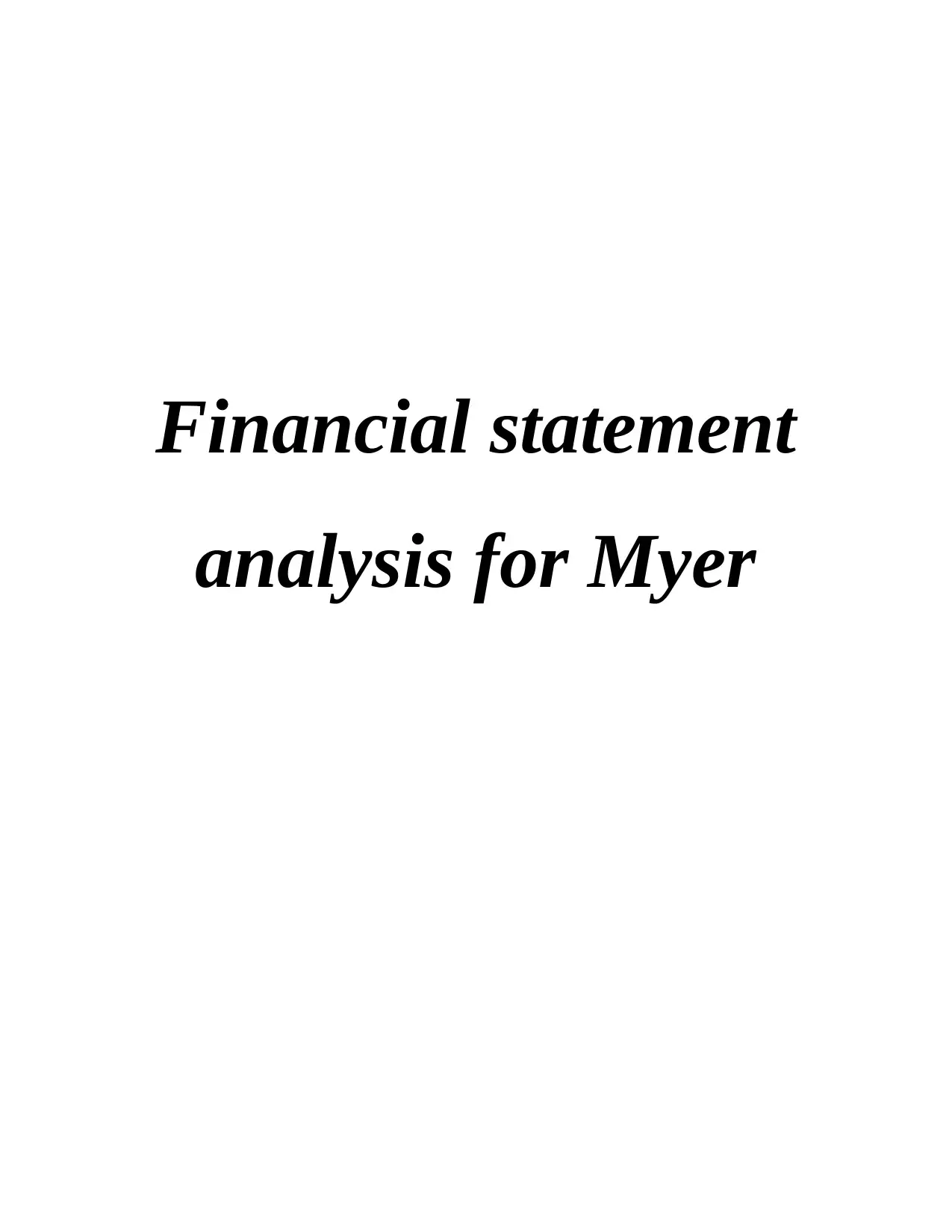
Financial statement
analysis for Myer
analysis for Myer
Paraphrase This Document
Need a fresh take? Get an instant paraphrase of this document with our AI Paraphraser
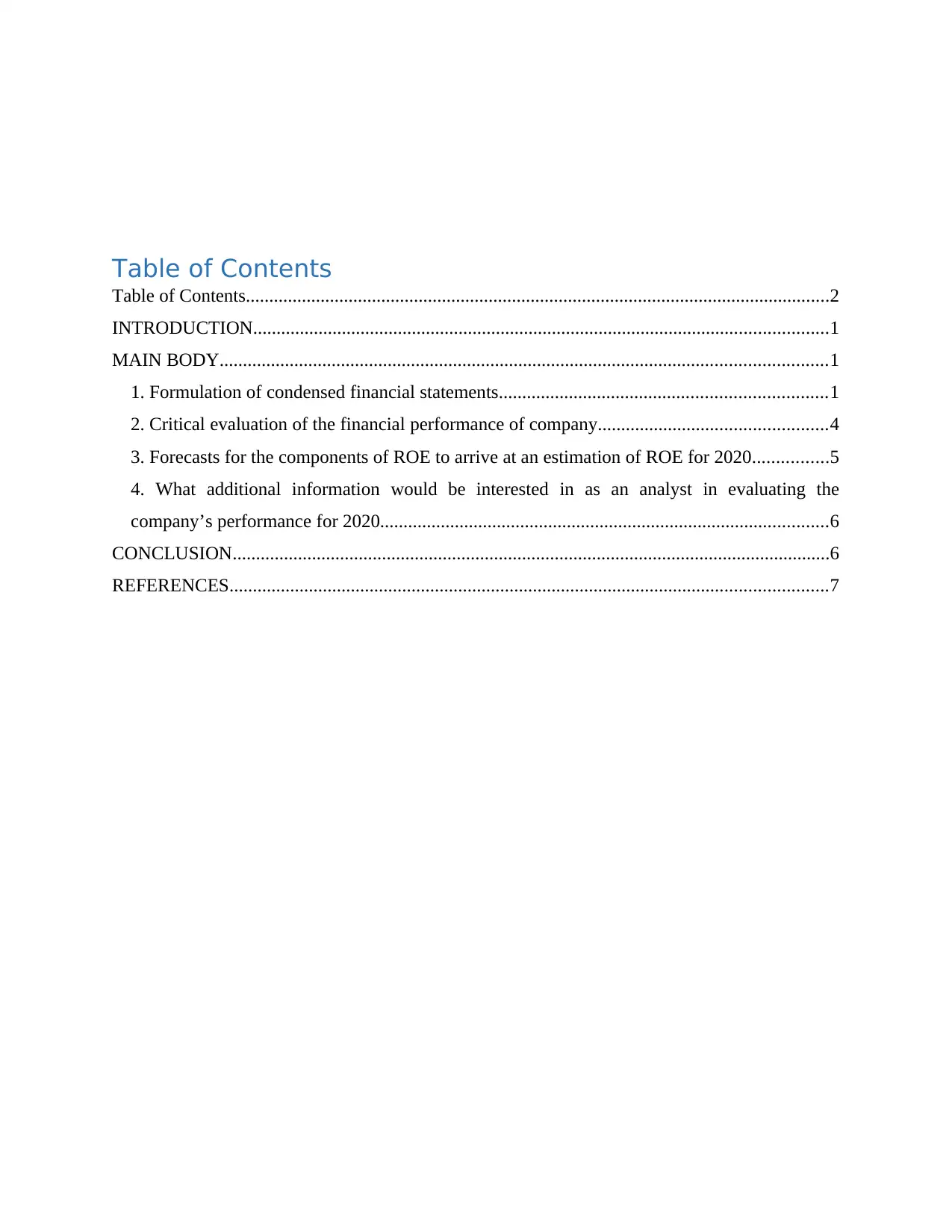
Table of Contents
Table of Contents.............................................................................................................................2
INTRODUCTION...........................................................................................................................1
MAIN BODY..................................................................................................................................1
1. Formulation of condensed financial statements......................................................................1
2. Critical evaluation of the financial performance of company.................................................4
3. Forecasts for the components of ROE to arrive at an estimation of ROE for 2020................5
4. What additional information would be interested in as an analyst in evaluating the
company’s performance for 2020................................................................................................6
CONCLUSION................................................................................................................................6
REFERENCES................................................................................................................................7
Table of Contents.............................................................................................................................2
INTRODUCTION...........................................................................................................................1
MAIN BODY..................................................................................................................................1
1. Formulation of condensed financial statements......................................................................1
2. Critical evaluation of the financial performance of company.................................................4
3. Forecasts for the components of ROE to arrive at an estimation of ROE for 2020................5
4. What additional information would be interested in as an analyst in evaluating the
company’s performance for 2020................................................................................................6
CONCLUSION................................................................................................................................6
REFERENCES................................................................................................................................7
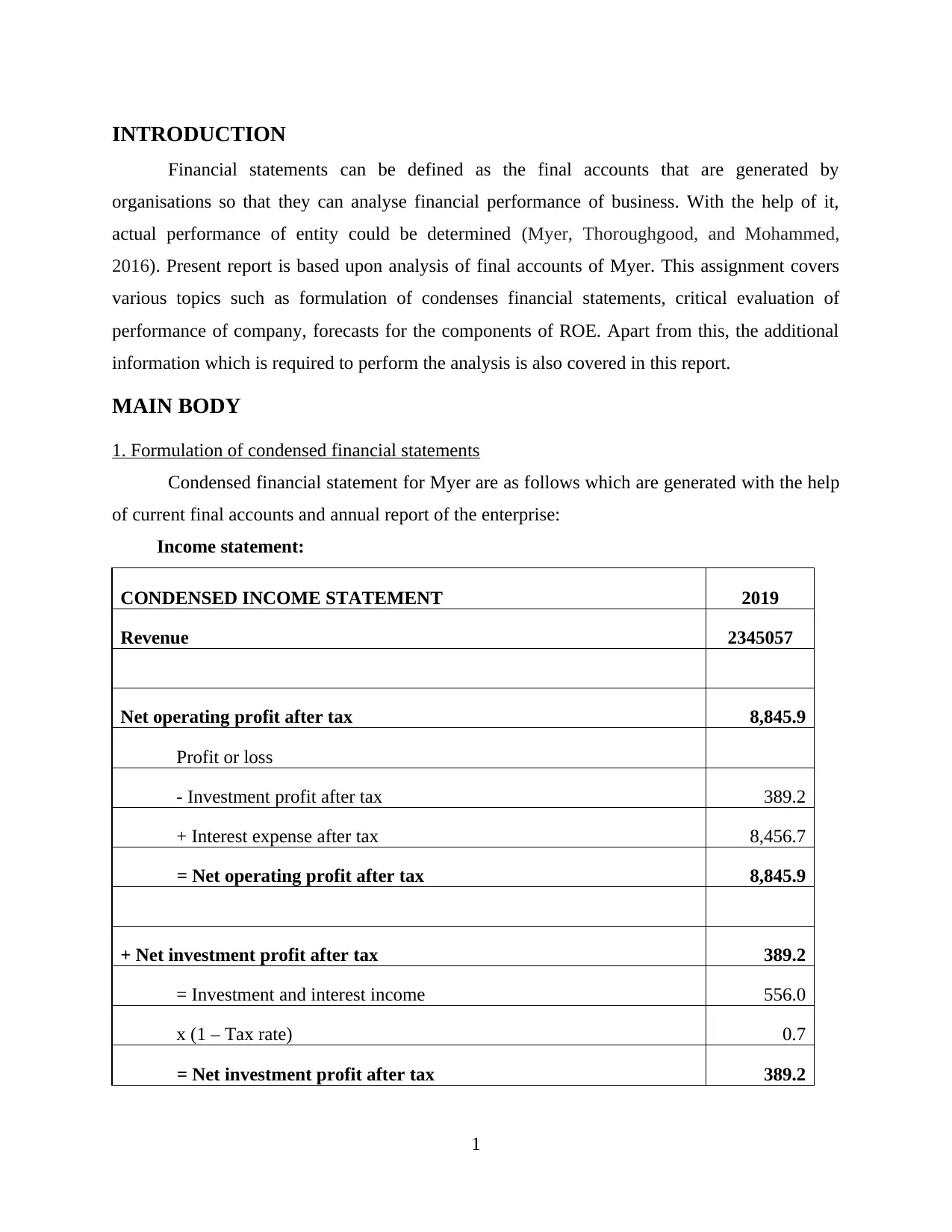
INTRODUCTION
Financial statements can be defined as the final accounts that are generated by
organisations so that they can analyse financial performance of business. With the help of it,
actual performance of entity could be determined (Myer, Thoroughgood, and Mohammed,
2016). Present report is based upon analysis of final accounts of Myer. This assignment covers
various topics such as formulation of condenses financial statements, critical evaluation of
performance of company, forecasts for the components of ROE. Apart from this, the additional
information which is required to perform the analysis is also covered in this report.
MAIN BODY
1. Formulation of condensed financial statements
Condensed financial statement for Myer are as follows which are generated with the help
of current final accounts and annual report of the enterprise:
Income statement:
CONDENSED INCOME STATEMENT 2019
Revenue 2345057
Net operating profit after tax 8,845.9
Profit or loss
- Investment profit after tax 389.2
+ Interest expense after tax 8,456.7
= Net operating profit after tax 8,845.9
+ Net investment profit after tax 389.2
= Investment and interest income 556.0
x (1 – Tax rate) 0.7
= Net investment profit after tax 389.2
1
Financial statements can be defined as the final accounts that are generated by
organisations so that they can analyse financial performance of business. With the help of it,
actual performance of entity could be determined (Myer, Thoroughgood, and Mohammed,
2016). Present report is based upon analysis of final accounts of Myer. This assignment covers
various topics such as formulation of condenses financial statements, critical evaluation of
performance of company, forecasts for the components of ROE. Apart from this, the additional
information which is required to perform the analysis is also covered in this report.
MAIN BODY
1. Formulation of condensed financial statements
Condensed financial statement for Myer are as follows which are generated with the help
of current final accounts and annual report of the enterprise:
Income statement:
CONDENSED INCOME STATEMENT 2019
Revenue 2345057
Net operating profit after tax 8,845.9
Profit or loss
- Investment profit after tax 389.2
+ Interest expense after tax 8,456.7
= Net operating profit after tax 8,845.9
+ Net investment profit after tax 389.2
= Investment and interest income 556.0
x (1 – Tax rate) 0.7
= Net investment profit after tax 389.2
1
You're viewing a preview
Unlock full access by subscribing today!
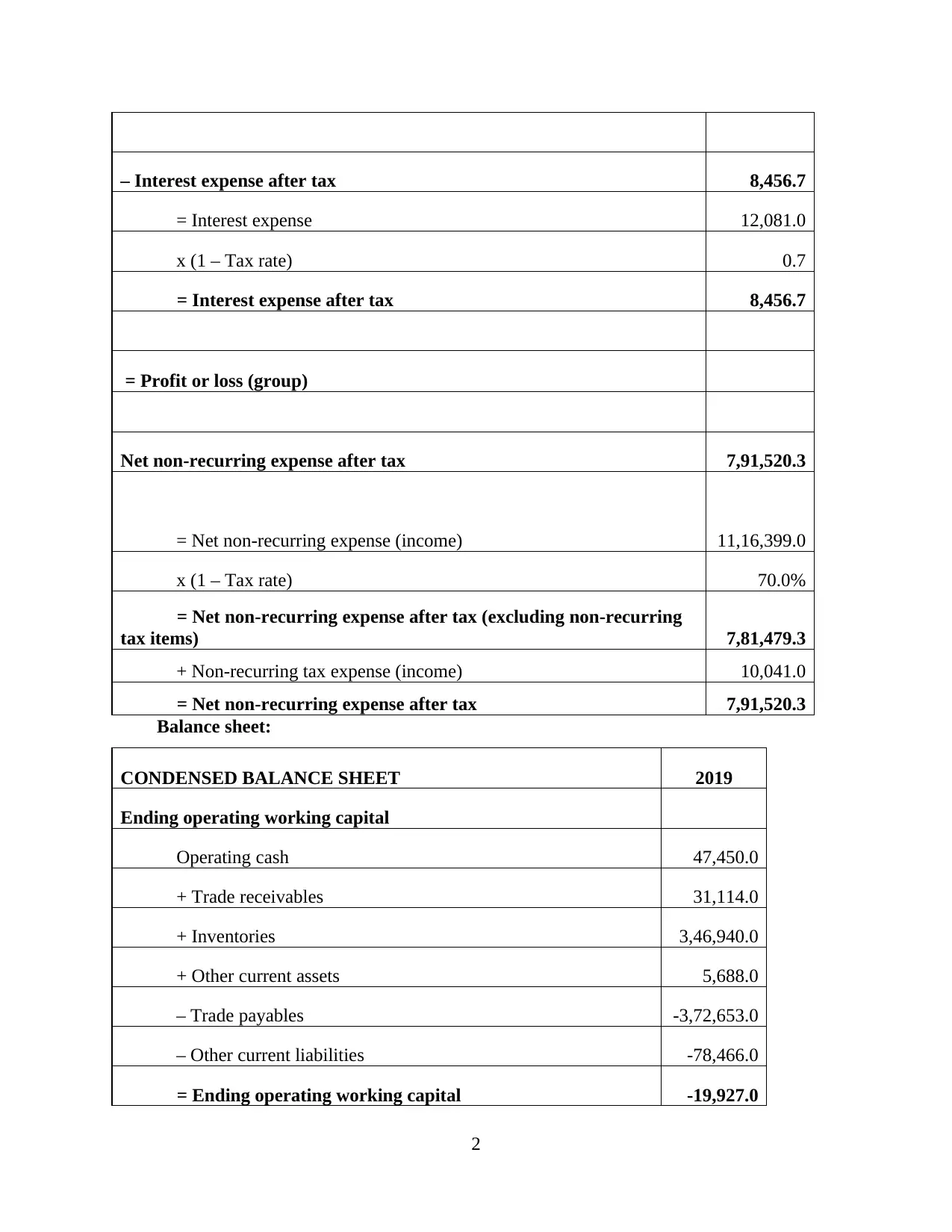
– Interest expense after tax 8,456.7
= Interest expense 12,081.0
x (1 – Tax rate) 0.7
= Interest expense after tax 8,456.7
= Profit or loss (group)
Net non-recurring expense after tax 7,91,520.3
= Net non-recurring expense (income) 11,16,399.0
x (1 – Tax rate) 70.0%
= Net non-recurring expense after tax (excluding non-recurring
tax items) 7,81,479.3
+ Non-recurring tax expense (income) 10,041.0
= Net non-recurring expense after tax 7,91,520.3
Balance sheet:
CONDENSED BALANCE SHEET 2019
Ending operating working capital
Operating cash 47,450.0
+ Trade receivables 31,114.0
+ Inventories 3,46,940.0
+ Other current assets 5,688.0
– Trade payables -3,72,653.0
– Other current liabilities -78,466.0
= Ending operating working capital -19,927.0
2
= Interest expense 12,081.0
x (1 – Tax rate) 0.7
= Interest expense after tax 8,456.7
= Profit or loss (group)
Net non-recurring expense after tax 7,91,520.3
= Net non-recurring expense (income) 11,16,399.0
x (1 – Tax rate) 70.0%
= Net non-recurring expense after tax (excluding non-recurring
tax items) 7,81,479.3
+ Non-recurring tax expense (income) 10,041.0
= Net non-recurring expense after tax 7,91,520.3
Balance sheet:
CONDENSED BALANCE SHEET 2019
Ending operating working capital
Operating cash 47,450.0
+ Trade receivables 31,114.0
+ Inventories 3,46,940.0
+ Other current assets 5,688.0
– Trade payables -3,72,653.0
– Other current liabilities -78,466.0
= Ending operating working capital -19,927.0
2
Paraphrase This Document
Need a fresh take? Get an instant paraphrase of this document with our AI Paraphraser
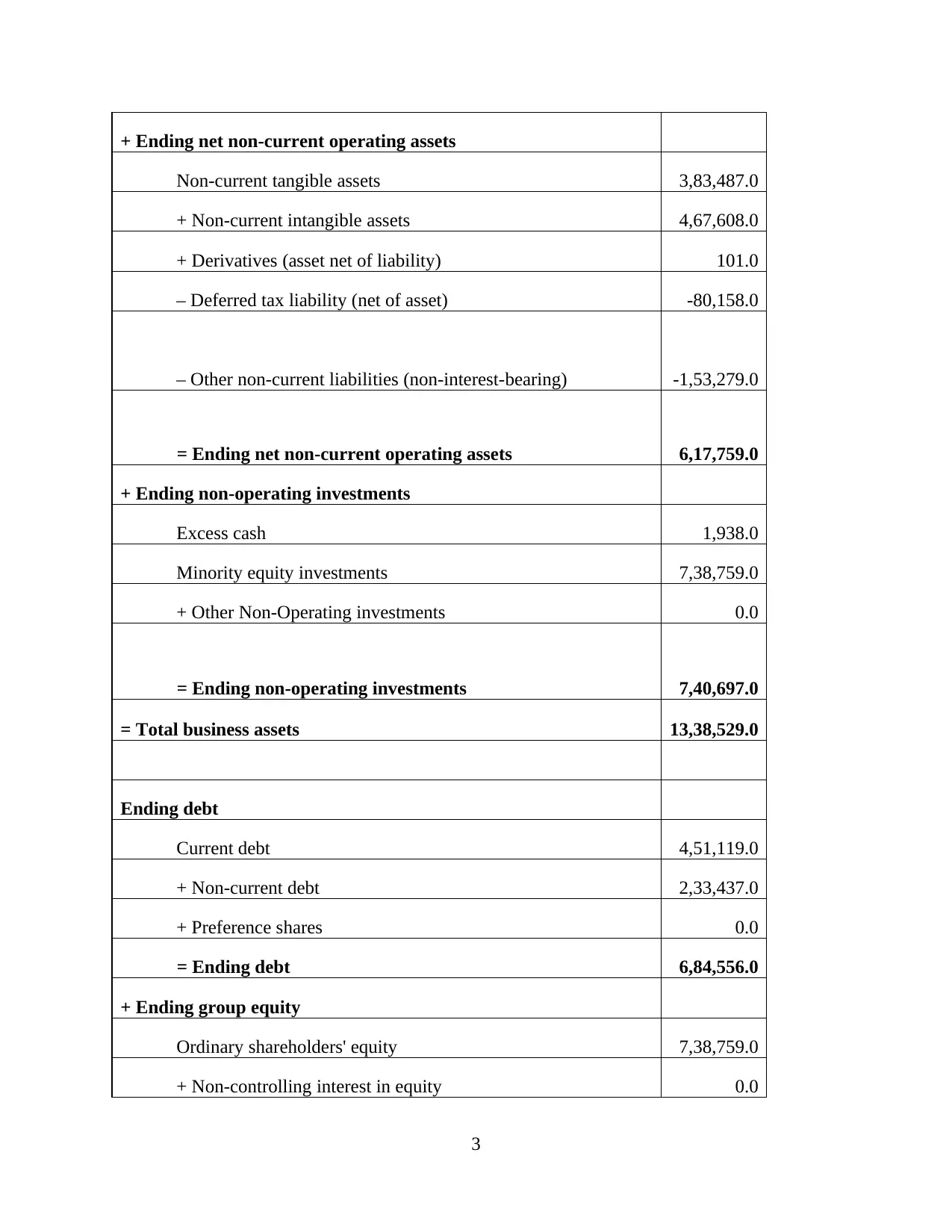
+ Ending net non-current operating assets
Non-current tangible assets 3,83,487.0
+ Non-current intangible assets 4,67,608.0
+ Derivatives (asset net of liability) 101.0
– Deferred tax liability (net of asset) -80,158.0
– Other non-current liabilities (non-interest-bearing) -1,53,279.0
= Ending net non-current operating assets 6,17,759.0
+ Ending non-operating investments
Excess cash 1,938.0
Minority equity investments 7,38,759.0
+ Other Non-Operating investments 0.0
= Ending non-operating investments 7,40,697.0
= Total business assets 13,38,529.0
Ending debt
Current debt 4,51,119.0
+ Non-current debt 2,33,437.0
+ Preference shares 0.0
= Ending debt 6,84,556.0
+ Ending group equity
Ordinary shareholders' equity 7,38,759.0
+ Non-controlling interest in equity 0.0
3
Non-current tangible assets 3,83,487.0
+ Non-current intangible assets 4,67,608.0
+ Derivatives (asset net of liability) 101.0
– Deferred tax liability (net of asset) -80,158.0
– Other non-current liabilities (non-interest-bearing) -1,53,279.0
= Ending net non-current operating assets 6,17,759.0
+ Ending non-operating investments
Excess cash 1,938.0
Minority equity investments 7,38,759.0
+ Other Non-Operating investments 0.0
= Ending non-operating investments 7,40,697.0
= Total business assets 13,38,529.0
Ending debt
Current debt 4,51,119.0
+ Non-current debt 2,33,437.0
+ Preference shares 0.0
= Ending debt 6,84,556.0
+ Ending group equity
Ordinary shareholders' equity 7,38,759.0
+ Non-controlling interest in equity 0.0
3
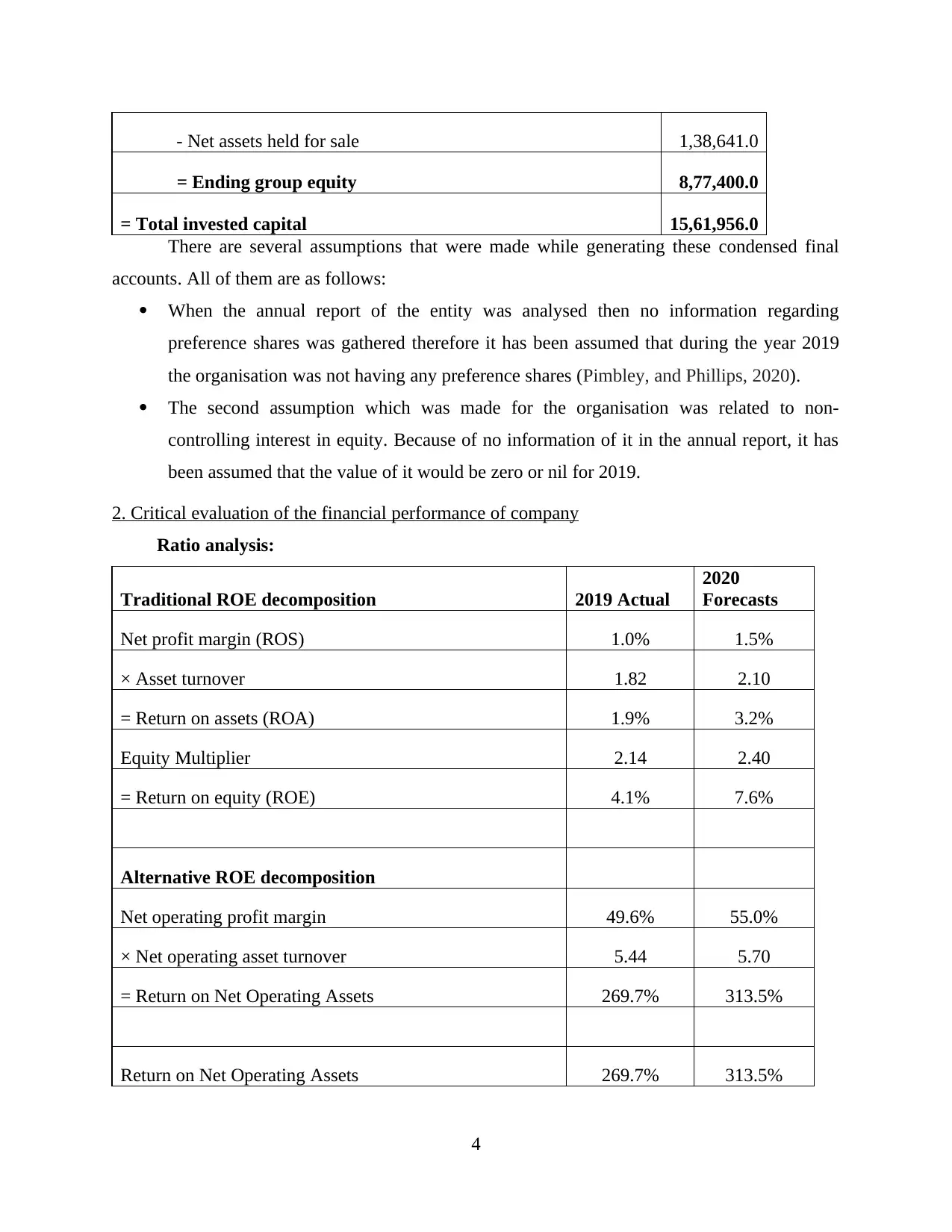
- Net assets held for sale 1,38,641.0
= Ending group equity 8,77,400.0
= Total invested capital 15,61,956.0
There are several assumptions that were made while generating these condensed final
accounts. All of them are as follows:
When the annual report of the entity was analysed then no information regarding
preference shares was gathered therefore it has been assumed that during the year 2019
the organisation was not having any preference shares (Pimbley, and Phillips, 2020).
The second assumption which was made for the organisation was related to non-
controlling interest in equity. Because of no information of it in the annual report, it has
been assumed that the value of it would be zero or nil for 2019.
2. Critical evaluation of the financial performance of company
Ratio analysis:
Traditional ROE decomposition 2019 Actual
2020
Forecasts
Net profit margin (ROS) 1.0% 1.5%
× Asset turnover 1.82 2.10
= Return on assets (ROA) 1.9% 3.2%
Equity Multiplier 2.14 2.40
= Return on equity (ROE) 4.1% 7.6%
Alternative ROE decomposition
Net operating profit margin 49.6% 55.0%
× Net operating asset turnover 5.44 5.70
= Return on Net Operating Assets 269.7% 313.5%
Return on Net Operating Assets 269.7% 313.5%
4
= Ending group equity 8,77,400.0
= Total invested capital 15,61,956.0
There are several assumptions that were made while generating these condensed final
accounts. All of them are as follows:
When the annual report of the entity was analysed then no information regarding
preference shares was gathered therefore it has been assumed that during the year 2019
the organisation was not having any preference shares (Pimbley, and Phillips, 2020).
The second assumption which was made for the organisation was related to non-
controlling interest in equity. Because of no information of it in the annual report, it has
been assumed that the value of it would be zero or nil for 2019.
2. Critical evaluation of the financial performance of company
Ratio analysis:
Traditional ROE decomposition 2019 Actual
2020
Forecasts
Net profit margin (ROS) 1.0% 1.5%
× Asset turnover 1.82 2.10
= Return on assets (ROA) 1.9% 3.2%
Equity Multiplier 2.14 2.40
= Return on equity (ROE) 4.1% 7.6%
Alternative ROE decomposition
Net operating profit margin 49.6% 55.0%
× Net operating asset turnover 5.44 5.70
= Return on Net Operating Assets 269.7% 313.5%
Return on Net Operating Assets 269.7% 313.5%
4
You're viewing a preview
Unlock full access by subscribing today!
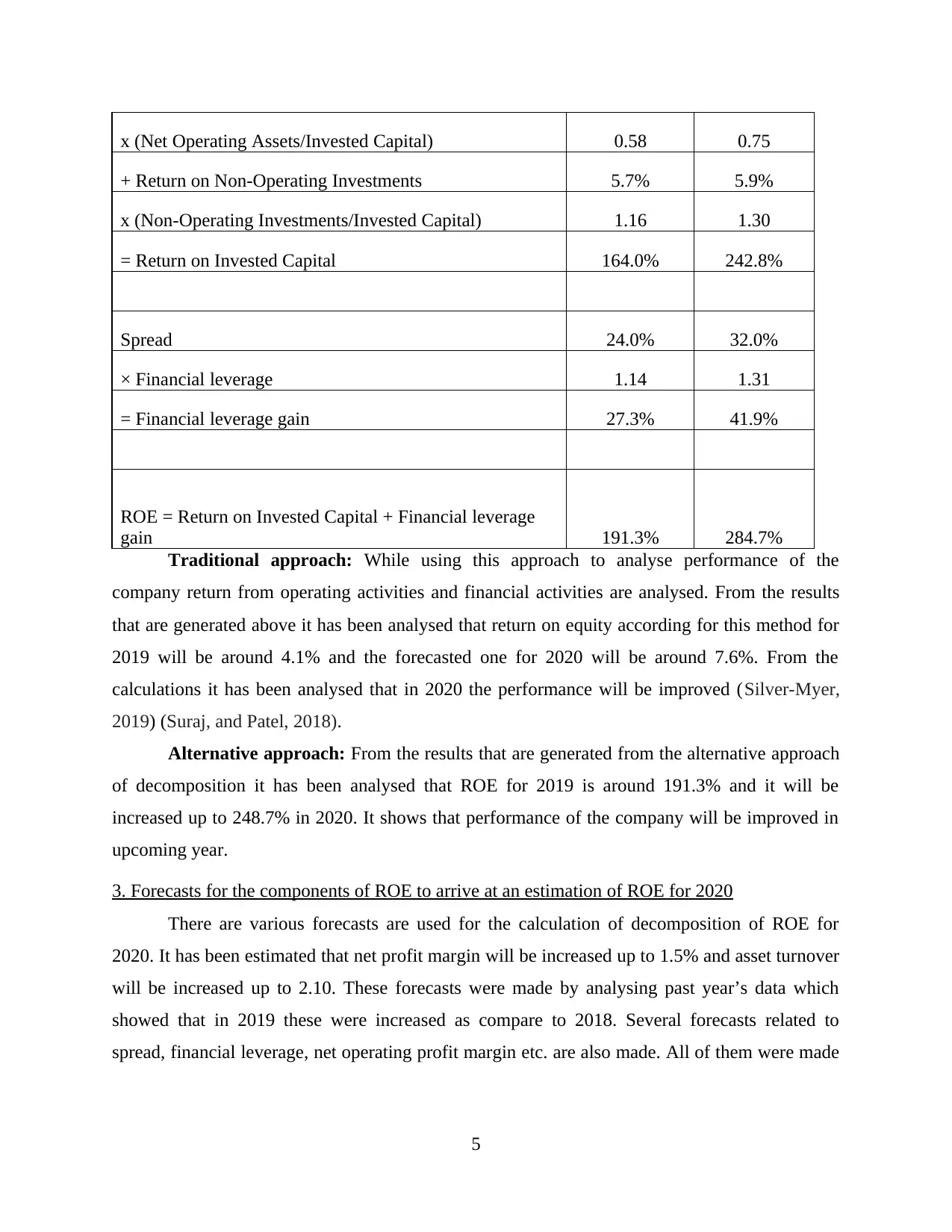
x (Net Operating Assets/Invested Capital) 0.58 0.75
+ Return on Non-Operating Investments 5.7% 5.9%
x (Non-Operating Investments/Invested Capital) 1.16 1.30
= Return on Invested Capital 164.0% 242.8%
Spread 24.0% 32.0%
× Financial leverage 1.14 1.31
= Financial leverage gain 27.3% 41.9%
ROE = Return on Invested Capital + Financial leverage
gain 191.3% 284.7%
Traditional approach: While using this approach to analyse performance of the
company return from operating activities and financial activities are analysed. From the results
that are generated above it has been analysed that return on equity according for this method for
2019 will be around 4.1% and the forecasted one for 2020 will be around 7.6%. From the
calculations it has been analysed that in 2020 the performance will be improved (Silver-Myer,
2019) (Suraj, and Patel, 2018).
Alternative approach: From the results that are generated from the alternative approach
of decomposition it has been analysed that ROE for 2019 is around 191.3% and it will be
increased up to 248.7% in 2020. It shows that performance of the company will be improved in
upcoming year.
3. Forecasts for the components of ROE to arrive at an estimation of ROE for 2020
There are various forecasts are used for the calculation of decomposition of ROE for
2020. It has been estimated that net profit margin will be increased up to 1.5% and asset turnover
will be increased up to 2.10. These forecasts were made by analysing past year’s data which
showed that in 2019 these were increased as compare to 2018. Several forecasts related to
spread, financial leverage, net operating profit margin etc. are also made. All of them were made
5
+ Return on Non-Operating Investments 5.7% 5.9%
x (Non-Operating Investments/Invested Capital) 1.16 1.30
= Return on Invested Capital 164.0% 242.8%
Spread 24.0% 32.0%
× Financial leverage 1.14 1.31
= Financial leverage gain 27.3% 41.9%
ROE = Return on Invested Capital + Financial leverage
gain 191.3% 284.7%
Traditional approach: While using this approach to analyse performance of the
company return from operating activities and financial activities are analysed. From the results
that are generated above it has been analysed that return on equity according for this method for
2019 will be around 4.1% and the forecasted one for 2020 will be around 7.6%. From the
calculations it has been analysed that in 2020 the performance will be improved (Silver-Myer,
2019) (Suraj, and Patel, 2018).
Alternative approach: From the results that are generated from the alternative approach
of decomposition it has been analysed that ROE for 2019 is around 191.3% and it will be
increased up to 248.7% in 2020. It shows that performance of the company will be improved in
upcoming year.
3. Forecasts for the components of ROE to arrive at an estimation of ROE for 2020
There are various forecasts are used for the calculation of decomposition of ROE for
2020. It has been estimated that net profit margin will be increased up to 1.5% and asset turnover
will be increased up to 2.10. These forecasts were made by analysing past year’s data which
showed that in 2019 these were increased as compare to 2018. Several forecasts related to
spread, financial leverage, net operating profit margin etc. are also made. All of them were made
5
Paraphrase This Document
Need a fresh take? Get an instant paraphrase of this document with our AI Paraphraser
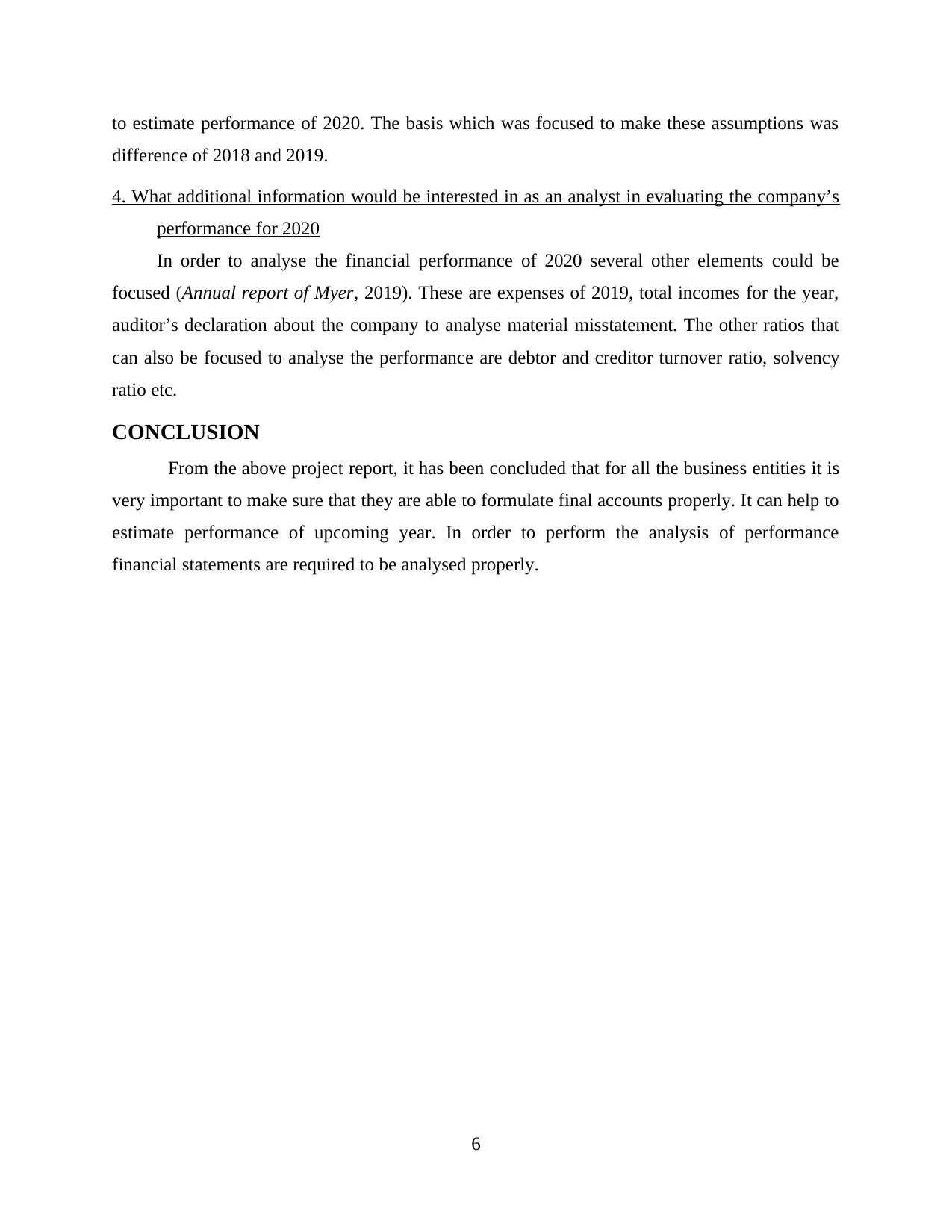
to estimate performance of 2020. The basis which was focused to make these assumptions was
difference of 2018 and 2019.
4. What additional information would be interested in as an analyst in evaluating the company’s
performance for 2020
In order to analyse the financial performance of 2020 several other elements could be
focused (Annual report of Myer, 2019). These are expenses of 2019, total incomes for the year,
auditor’s declaration about the company to analyse material misstatement. The other ratios that
can also be focused to analyse the performance are debtor and creditor turnover ratio, solvency
ratio etc.
CONCLUSION
From the above project report, it has been concluded that for all the business entities it is
very important to make sure that they are able to formulate final accounts properly. It can help to
estimate performance of upcoming year. In order to perform the analysis of performance
financial statements are required to be analysed properly.
6
difference of 2018 and 2019.
4. What additional information would be interested in as an analyst in evaluating the company’s
performance for 2020
In order to analyse the financial performance of 2020 several other elements could be
focused (Annual report of Myer, 2019). These are expenses of 2019, total incomes for the year,
auditor’s declaration about the company to analyse material misstatement. The other ratios that
can also be focused to analyse the performance are debtor and creditor turnover ratio, solvency
ratio etc.
CONCLUSION
From the above project report, it has been concluded that for all the business entities it is
very important to make sure that they are able to formulate final accounts properly. It can help to
estimate performance of upcoming year. In order to perform the analysis of performance
financial statements are required to be analysed properly.
6
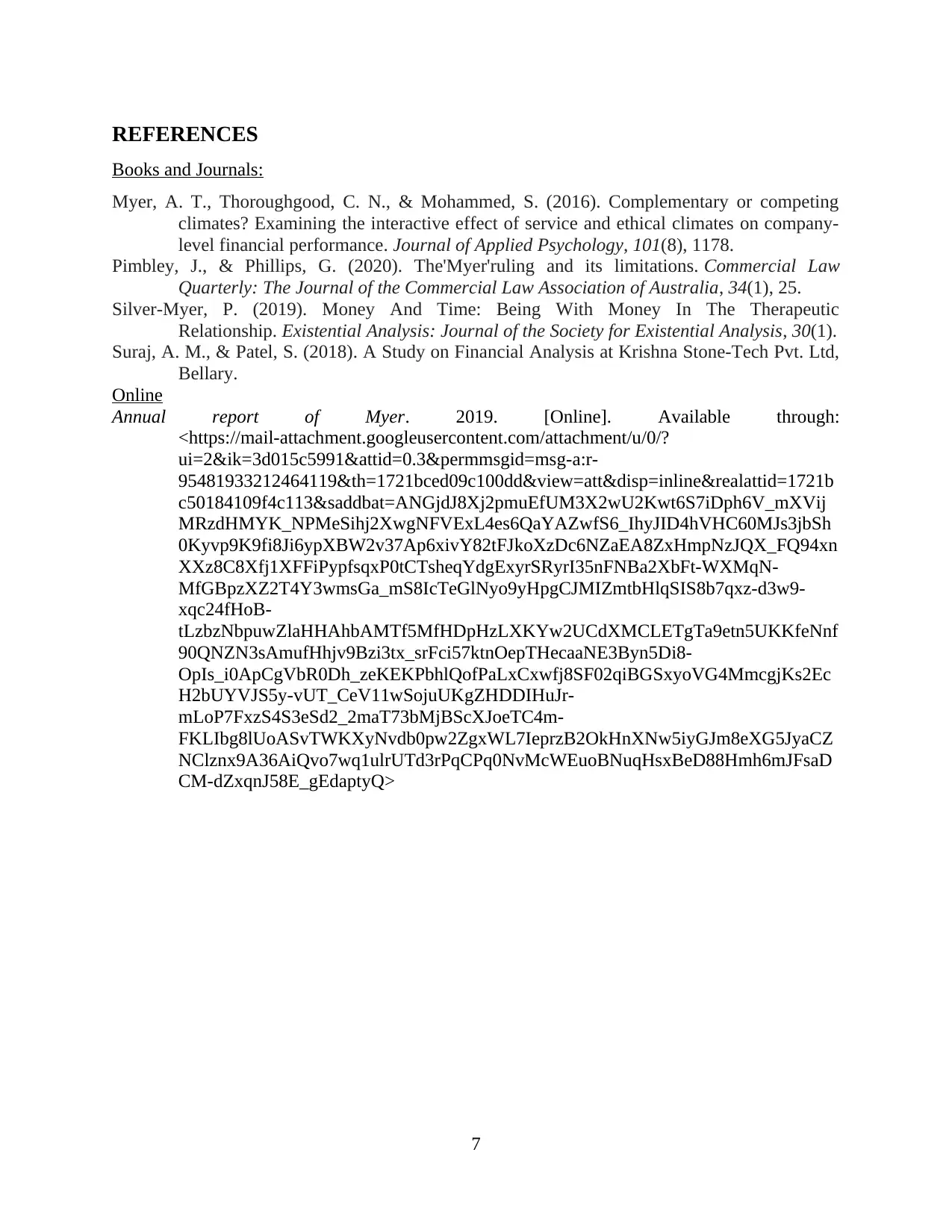
REFERENCES
Books and Journals:
Myer, A. T., Thoroughgood, C. N., & Mohammed, S. (2016). Complementary or competing
climates? Examining the interactive effect of service and ethical climates on company-
level financial performance. Journal of Applied Psychology, 101(8), 1178.
Pimbley, J., & Phillips, G. (2020). The'Myer'ruling and its limitations. Commercial Law
Quarterly: The Journal of the Commercial Law Association of Australia, 34(1), 25.
Silver-Myer, P. (2019). Money And Time: Being With Money In The Therapeutic
Relationship. Existential Analysis: Journal of the Society for Existential Analysis, 30(1).
Suraj, A. M., & Patel, S. (2018). A Study on Financial Analysis at Krishna Stone-Tech Pvt. Ltd,
Bellary.
Online
Annual report of Myer. 2019. [Online]. Available through:
<https://mail-attachment.googleusercontent.com/attachment/u/0/?
ui=2&ik=3d015c5991&attid=0.3&permmsgid=msg-a:r-
95481933212464119&th=1721bced09c100dd&view=att&disp=inline&realattid=1721b
c50184109f4c113&saddbat=ANGjdJ8Xj2pmuEfUM3X2wU2Kwt6S7iDph6V_mXVij
MRzdHMYK_NPMeSihj2XwgNFVExL4es6QaYAZwfS6_IhyJID4hVHC60MJs3jbSh
0Kyvp9K9fi8Ji6ypXBW2v37Ap6xivY82tFJkoXzDc6NZaEA8ZxHmpNzJQX_FQ94xn
XXz8C8Xfj1XFFiPypfsqxP0tCTsheqYdgExyrSRyrI35nFNBa2XbFt-WXMqN-
MfGBpzXZ2T4Y3wmsGa_mS8IcTeGlNyo9yHpgCJMIZmtbHlqSIS8b7qxz-d3w9-
xqc24fHoB-
tLzbzNbpuwZlaHHAhbAMTf5MfHDpHzLXKYw2UCdXMCLETgTa9etn5UKKfeNnf
90QNZN3sAmufHhjv9Bzi3tx_srFci57ktnOepTHecaaNE3Byn5Di8-
OpIs_i0ApCgVbR0Dh_zeKEKPbhlQofPaLxCxwfj8SF02qiBGSxyoVG4MmcgjKs2Ec
H2bUYVJS5y-vUT_CeV11wSojuUKgZHDDIHuJr-
mLoP7FxzS4S3eSd2_2maT73bMjBScXJoeTC4m-
FKLIbg8lUoASvTWKXyNvdb0pw2ZgxWL7IeprzB2OkHnXNw5iyGJm8eXG5JyaCZ
NClznx9A36AiQvo7wq1ulrUTd3rPqCPq0NvMcWEuoBNuqHsxBeD88Hmh6mJFsaD
CM-dZxqnJ58E_gEdaptyQ>
7
Books and Journals:
Myer, A. T., Thoroughgood, C. N., & Mohammed, S. (2016). Complementary or competing
climates? Examining the interactive effect of service and ethical climates on company-
level financial performance. Journal of Applied Psychology, 101(8), 1178.
Pimbley, J., & Phillips, G. (2020). The'Myer'ruling and its limitations. Commercial Law
Quarterly: The Journal of the Commercial Law Association of Australia, 34(1), 25.
Silver-Myer, P. (2019). Money And Time: Being With Money In The Therapeutic
Relationship. Existential Analysis: Journal of the Society for Existential Analysis, 30(1).
Suraj, A. M., & Patel, S. (2018). A Study on Financial Analysis at Krishna Stone-Tech Pvt. Ltd,
Bellary.
Online
Annual report of Myer. 2019. [Online]. Available through:
<https://mail-attachment.googleusercontent.com/attachment/u/0/?
ui=2&ik=3d015c5991&attid=0.3&permmsgid=msg-a:r-
95481933212464119&th=1721bced09c100dd&view=att&disp=inline&realattid=1721b
c50184109f4c113&saddbat=ANGjdJ8Xj2pmuEfUM3X2wU2Kwt6S7iDph6V_mXVij
MRzdHMYK_NPMeSihj2XwgNFVExL4es6QaYAZwfS6_IhyJID4hVHC60MJs3jbSh
0Kyvp9K9fi8Ji6ypXBW2v37Ap6xivY82tFJkoXzDc6NZaEA8ZxHmpNzJQX_FQ94xn
XXz8C8Xfj1XFFiPypfsqxP0tCTsheqYdgExyrSRyrI35nFNBa2XbFt-WXMqN-
MfGBpzXZ2T4Y3wmsGa_mS8IcTeGlNyo9yHpgCJMIZmtbHlqSIS8b7qxz-d3w9-
xqc24fHoB-
tLzbzNbpuwZlaHHAhbAMTf5MfHDpHzLXKYw2UCdXMCLETgTa9etn5UKKfeNnf
90QNZN3sAmufHhjv9Bzi3tx_srFci57ktnOepTHecaaNE3Byn5Di8-
OpIs_i0ApCgVbR0Dh_zeKEKPbhlQofPaLxCxwfj8SF02qiBGSxyoVG4MmcgjKs2Ec
H2bUYVJS5y-vUT_CeV11wSojuUKgZHDDIHuJr-
mLoP7FxzS4S3eSd2_2maT73bMjBScXJoeTC4m-
FKLIbg8lUoASvTWKXyNvdb0pw2ZgxWL7IeprzB2OkHnXNw5iyGJm8eXG5JyaCZ
NClznx9A36AiQvo7wq1ulrUTd3rPqCPq0NvMcWEuoBNuqHsxBeD88Hmh6mJFsaD
CM-dZxqnJ58E_gEdaptyQ>
7
You're viewing a preview
Unlock full access by subscribing today!
1 out of 9
Related Documents
Your All-in-One AI-Powered Toolkit for Academic Success.
+13062052269
info@desklib.com
Available 24*7 on WhatsApp / Email
![[object Object]](/_next/static/media/star-bottom.7253800d.svg)
Unlock your academic potential
© 2024 | Zucol Services PVT LTD | All rights reserved.





